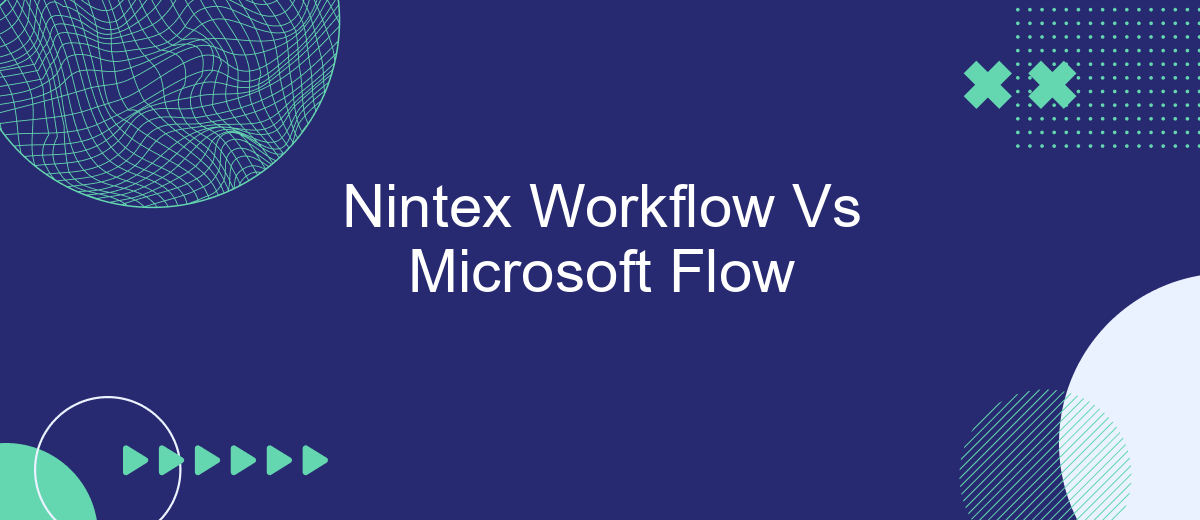When it comes to automating business processes, choosing the right workflow tool is crucial. Nintex Workflow and Microsoft Flow (now Power Automate) are two popular options, each offering unique features and capabilities. This article compares these platforms, examining their strengths and weaknesses to help you make an informed decision on which solution best fits your organization's needs.
Introduction
In today's fast-paced business environment, automating workflows is crucial for efficiency and productivity. Two popular tools for achieving this are Nintex Workflow and Microsoft Flow (now known as Power Automate). Both platforms offer robust solutions for creating automated workflows, but they cater to different needs and preferences.
- Nintex Workflow: Known for its user-friendly interface and powerful capabilities, Nintex Workflow is ideal for organizations seeking advanced workflow automation without extensive coding.
- Microsoft Flow (Power Automate): Integrated with the Microsoft ecosystem, this tool excels in connecting various Microsoft services and third-party applications, making it a versatile choice for businesses heavily reliant on Microsoft products.
Choosing between Nintex Workflow and Microsoft Flow depends on your specific requirements, existing infrastructure, and budget. Additionally, services like SaveMyLeads can further enhance your automation by seamlessly integrating various platforms and applications, ensuring a smooth and efficient workflow automation process.
Similarities and Differences

Nintex Workflow and Microsoft Flow (now called Power Automate) are both powerful tools for automating business processes. Both platforms offer drag-and-drop interfaces, making it easy for users to create workflows without extensive coding knowledge. They also support a wide range of integrations with other applications and services, helping businesses streamline their operations. For instance, services like SaveMyLeads can be integrated with both platforms to automatically capture and manage leads from various sources.
However, there are notable differences between the two. Nintex Workflow is often praised for its deep integration with SharePoint and Office 365, offering advanced document management capabilities. On the other hand, Power Automate excels in its extensive library of connectors, allowing for broader integration with third-party applications. Additionally, Power Automate benefits from being part of the Microsoft Power Platform, which includes tools like Power BI and Power Apps, providing a more comprehensive suite for business automation. Therefore, the choice between the two may depend on the specific needs and existing infrastructure of the organization.
Key Features and Benefits

When comparing Nintex Workflow and Microsoft Flow, it's essential to consider the key features and benefits that each platform offers. Both tools are designed to automate workflows and enhance productivity, but they have unique strengths that cater to different business needs.
- Ease of Use: Both Nintex Workflow and Microsoft Flow provide user-friendly interfaces, but Nintex is often praised for its drag-and-drop design capabilities, making it accessible for users without technical expertise.
- Integration Capabilities: Microsoft Flow, now known as Power Automate, seamlessly integrates with the Microsoft ecosystem, including Office 365, Dynamics 365, and Azure. Nintex, on the other hand, offers extensive third-party integrations and can connect with various cloud services and on-premises applications.
- Customization and Flexibility: Nintex provides advanced customization options, allowing for complex workflow designs and conditional logic. Microsoft Flow excels in its flexibility, offering numerous templates and connectors to streamline processes.
- Automation and Efficiency: Both platforms enhance business efficiency by automating repetitive tasks. Nintex is particularly strong in document generation and approval workflows, while Microsoft Flow offers robust automation capabilities across various Microsoft services.
In summary, the choice between Nintex Workflow and Microsoft Flow largely depends on your specific business requirements and existing technology stack. For those heavily invested in Microsoft products, Power Automate might be the preferred choice. However, if you need broader integration options and advanced workflow customization, Nintex Workflow could be more suitable. Additionally, services like SaveMyLeads can further enhance your automation strategy by simplifying the integration of various tools and platforms.
Pricing and Licensing

When comparing the pricing and licensing of Nintex Workflow and Microsoft Flow (now known as Power Automate), it's essential to consider the different pricing models and features each platform offers. Nintex Workflow typically operates on a subscription-based model, where costs can vary depending on the number of workflows and users.
Microsoft Flow, on the other hand, offers a more flexible pricing structure with both free and premium plans. The free plan includes basic functionalities, while the premium plans provide advanced features and additional integrations. This makes Power Automate a scalable solution for businesses of all sizes.
- Nintex Workflow: Subscription-based pricing, costs vary by number of workflows and users
- Microsoft Flow: Free and premium plans, scalable pricing based on features and integrations
Both platforms offer robust capabilities, but the choice between them may come down to your specific business needs and budget. For those looking to streamline integrations, services like SaveMyLeads can be a valuable addition, helping to automate and manage workflows more efficiently.
Conclusion
In conclusion, both Nintex Workflow and Microsoft Flow offer robust solutions for automating business processes, each with its own strengths and unique features. Nintex Workflow excels in its deep integration with SharePoint and its user-friendly interface, making it an ideal choice for organizations heavily invested in the Microsoft ecosystem. On the other hand, Microsoft Flow, now known as Power Automate, provides extensive connectivity with a wide range of third-party applications and services, offering greater flexibility for diverse business needs.
When choosing between the two, it's essential to consider your organization's specific requirements, existing infrastructure, and future scalability. Additionally, leveraging integration services such as SaveMyLeads can further enhance the capabilities of these workflow automation tools by simplifying the process of connecting various applications and automating data flows. Ultimately, the right choice will depend on your unique business context and the specific goals you aim to achieve with workflow automation.
FAQ
What are the primary differences between Nintex Workflow and Microsoft Flow?
Which platform is more user-friendly for non-technical users?
Can I integrate third-party applications with both Nintex Workflow and Microsoft Flow?
Which platform is better suited for enterprise-level workflow automation?
Is there a cost difference between Nintex Workflow and Microsoft Flow?
If you use Facebook Lead Ads, then you should know what it means to regularly download CSV files and transfer data to various support services. How many times a day do you check for new leads in your ad account? How often do you transfer data to a CRM system, task manager, email service or Google Sheets? Try using the SaveMyLeads online connector. This is a no-code tool with which anyone can set up integrations for Facebook. Spend just a few minutes and you will receive real-time notifications in the messenger about new leads. Another 5-10 minutes of work in SML, and the data from the FB advertising account will be automatically transferred to the CRM system or Email service. The SaveMyLeads system will do the routine work for you, and you will surely like it.
